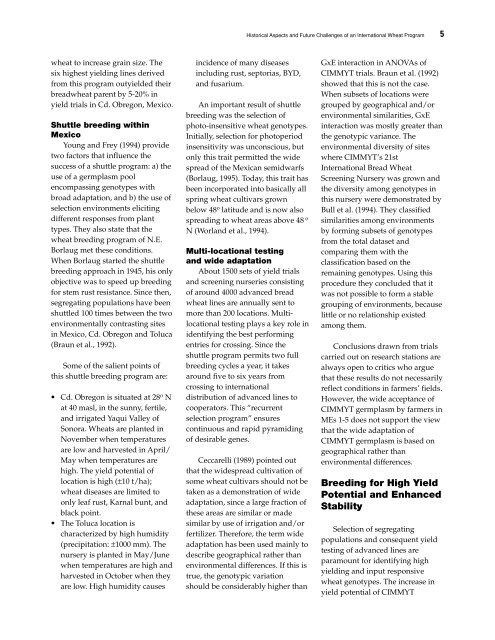Septoria and Stagonospora Diseases of Cereals - CIMMYT ...
Septoria and Stagonospora Diseases of Cereals - CIMMYT ...
Septoria and Stagonospora Diseases of Cereals - CIMMYT ...
Create successful ePaper yourself
Turn your PDF publications into a flip-book with our unique Google optimized e-Paper software.
wheat to increase grain size. The<br />
six highest yielding lines derived<br />
from this program outyielded their<br />
breadwheat parent by 5-20% in<br />
yield trials in Cd. Obregon, Mexico.<br />
Shuttle breeding within<br />
Mexico<br />
Young <strong>and</strong> Frey (1994) provide<br />
two factors that influence the<br />
success <strong>of</strong> a shuttle program: a) the<br />
use <strong>of</strong> a germplasm pool<br />
encompassing genotypes with<br />
broad adaptation, <strong>and</strong> b) the use <strong>of</strong><br />
selection environments eliciting<br />
different responses from plant<br />
types. They also state that the<br />
wheat breeding program <strong>of</strong> N.E.<br />
Borlaug met these conditions.<br />
When Borlaug started the shuttle<br />
breeding approach in 1945, his only<br />
objective was to speed up breeding<br />
for stem rust resistance. Since then,<br />
segregating populations have been<br />
shuttled 100 times between the two<br />
environmentally contrasting sites<br />
in Mexico, Cd. Obregon <strong>and</strong> Toluca<br />
(Braun et al., 1992).<br />
Some <strong>of</strong> the salient points <strong>of</strong><br />
this shuttle breeding program are:<br />
• Cd. Obregon is situated at 28 o N<br />
at 40 masl, in the sunny, fertile,<br />
<strong>and</strong> irrigated Yaqui Valley <strong>of</strong><br />
Sonora. Wheats are planted in<br />
November when temperatures<br />
are low <strong>and</strong> harvested in April/<br />
May when temperatures are<br />
high. The yield potential <strong>of</strong><br />
location is high (±10 t/ha);<br />
wheat diseases are limited to<br />
only leaf rust, Karnal bunt, <strong>and</strong><br />
black point.<br />
• The Toluca location is<br />
characterized by high humidity<br />
(precipitation: ±1000 mm). The<br />
nursery is planted in May/June<br />
when temperatures are high <strong>and</strong><br />
harvested in October when they<br />
are low. High humidity causes<br />
Historical Aspects <strong>and</strong> Future Challenges <strong>of</strong> an International Wheat Program 5<br />
incidence <strong>of</strong> many diseases<br />
including rust, septorias, BYD,<br />
<strong>and</strong> fusarium.<br />
An important result <strong>of</strong> shuttle<br />
breeding was the selection <strong>of</strong><br />
photo-insensitive wheat genotypes.<br />
Initially, selection for photoperiod<br />
insensitivity was unconscious, but<br />
only this trait permitted the wide<br />
spread <strong>of</strong> the Mexican semidwarfs<br />
(Borlaug, 1995). Today, this trait has<br />
been incorporated into basically all<br />
spring wheat cultivars grown<br />
below 48 o latitude <strong>and</strong> is now also<br />
spreading to wheat areas above 48 o<br />
N (Worl<strong>and</strong> et al., 1994).<br />
Multi-locational testing<br />
<strong>and</strong> wide adaptation<br />
About 1500 sets <strong>of</strong> yield trials<br />
<strong>and</strong> screening nurseries consisting<br />
<strong>of</strong> around 4000 advanced bread<br />
wheat lines are annually sent to<br />
more than 200 locations. Multilocational<br />
testing plays a key role in<br />
identifying the best performing<br />
entries for crossing. Since the<br />
shuttle program permits two full<br />
breeding cycles a year, it takes<br />
around five to six years from<br />
crossing to international<br />
distribution <strong>of</strong> advanced lines to<br />
cooperators. This “recurrent<br />
selection program” ensures<br />
continuous <strong>and</strong> rapid pyramiding<br />
<strong>of</strong> desirable genes.<br />
Ceccarelli (1989) pointed out<br />
that the widespread cultivation <strong>of</strong><br />
some wheat cultivars should not be<br />
taken as a demonstration <strong>of</strong> wide<br />
adaptation, since a large fraction <strong>of</strong><br />
these areas are similar or made<br />
similar by use <strong>of</strong> irrigation <strong>and</strong>/or<br />
fertilizer. Therefore, the term wide<br />
adaptation has been used mainly to<br />
describe geographical rather than<br />
environmental differences. If this is<br />
true, the genotypic variation<br />
should be considerably higher than<br />
GxE interaction in ANOVAs <strong>of</strong><br />
<strong>CIMMYT</strong> trials. Braun et al. (1992)<br />
showed that this is not the case.<br />
When subsets <strong>of</strong> locations were<br />
grouped by geographical <strong>and</strong>/or<br />
environmental similarities, GxE<br />
interaction was mostly greater than<br />
the genotypic variance. The<br />
environmental diversity <strong>of</strong> sites<br />
where <strong>CIMMYT</strong>’s 21st<br />
International Bread Wheat<br />
Screening Nursery was grown <strong>and</strong><br />
the diversity among genotypes in<br />
this nursery were demonstrated by<br />
Bull et al. (1994). They classified<br />
similarities among environments<br />
by forming subsets <strong>of</strong> genotypes<br />
from the total dataset <strong>and</strong><br />
comparing them with the<br />
classification based on the<br />
remaining genotypes. Using this<br />
procedure they concluded that it<br />
was not possible to form a stable<br />
grouping <strong>of</strong> environments, because<br />
little or no relationship existed<br />
among them.<br />
Conclusions drawn from trials<br />
carried out on research stations are<br />
always open to critics who argue<br />
that these results do not necessarily<br />
reflect conditions in farmers’ fields.<br />
However, the wide acceptance <strong>of</strong><br />
<strong>CIMMYT</strong> germplasm by farmers in<br />
MEs 1-5 does not support the view<br />
that the wide adaptation <strong>of</strong><br />
<strong>CIMMYT</strong> germplasm is based on<br />
geographical rather than<br />
environmental differences.<br />
Breeding for High Yield<br />
Potential <strong>and</strong> Enhanced<br />
Stability<br />
Selection <strong>of</strong> segregating<br />
populations <strong>and</strong> consequent yield<br />
testing <strong>of</strong> advanced lines are<br />
paramount for identifying high<br />
yielding <strong>and</strong> input responsive<br />
wheat genotypes. The increase in<br />
yield potential <strong>of</strong> <strong>CIMMYT</strong>









